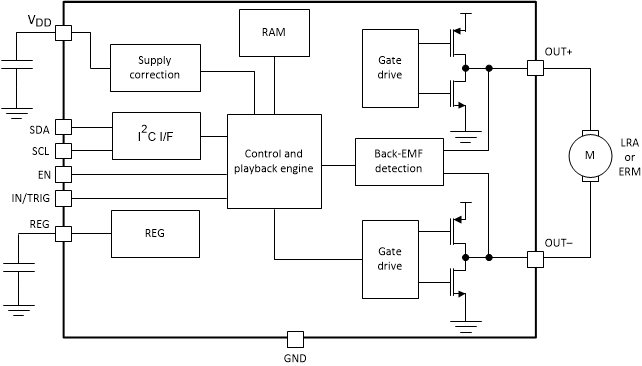-
DRV2604 ERMおよびLRA用触覚ドライバ、内部メモリおよびスマート・ループ・アーキテクチャ搭載
- 1 特長
- 2 アプリケーション
- 3 概要
- 4 改訂履歴
- 5 Pin Configuration and Functions
- 6 Specifications
-
7 Detailed Description
- 7.1 Overview
- 7.2 Functional Block Diagram
- 7.3
Feature Description
- 7.3.1 Support for ERM and LRA Actuators
- 7.3.2 Smart-Loop Architecture
- 7.3.3 Open-Loop Operation for LRA
- 7.3.4 Open-Loop Operation for ERM
- 7.3.5 Flexible Front-End Interface
- 7.3.6 Edge Rate Control
- 7.3.7 Constant Vibration Strength
- 7.3.8 Battery Voltage Reporting
- 7.3.9 One-Time Programmable (OTP) Memory for Configuration
- 7.3.10 Low-Power Standby
- 7.3.11 Device Protection
- 7.4 Device Functional Modes
- 7.5
Programming
- 7.5.1 Auto-Resonance Engine Programming for the LRA
- 7.5.2 Automatic-Level Calibration Programming
- 7.5.3 I2C Interface
- 7.5.4 Programming for Open-Loop Operation
- 7.5.5 Programming for Closed-Loop Operation
- 7.5.6 Auto Calibration Procedure
- 7.5.7 Programming On-Chip OTP Memory
- 7.5.8 Waveform Playback Programming
- 7.6
Register Map
- 7.6.1 Status (Address: 0x00)
- 7.6.2 Mode (Address: 0x01)
- 7.6.3 Real-Time Playback Input (Address: 0x02)
- 7.6.4 HI_Z (Address: 0x03)
- 7.6.5 Waveform Sequencer (Address: 0x04 to 0x0B)
- 7.6.6 GO (Address: 0x0C)
- 7.6.7 Overdrive Time Offset (Address: 0x0D)
- 7.6.8 Sustain Time Offset, Positive (Address: 0x0E)
- 7.6.9 Sustain Time Offset, Negative (Address: 0x0F)
- 7.6.10 Brake Time Offset (Address: 0x10)
- 7.6.11 Rated Voltage (Address: 0x16)
- 7.6.12 Overdrive Clamp Voltage (Address: 0x17)
- 7.6.13 Auto-Calibration Compensation Result (Address: 0x18)
- 7.6.14 Auto-Calibration Back-EMF Result (Address: 0x19)
- 7.6.15 Feedback Control (Address: 0x1A)
- 7.6.16 Control1 (Address: 0x1B)
- 7.6.17 Control2 (Address: 0x1C)
- 7.6.18 Control3 (Address: 0x1D)
- 7.6.19 Control4 (Address: 0x1E)
- 7.6.20 V(BAT) Voltage Monitor (Address: 0x21)
- 7.6.21 LRA Resonance Period (Address: 0x22)
- 7.6.22 RAM-Address Upper Byte (Address: 0xFD)
- 7.6.23 RAM-Address Lower Byte (Address: 0xFE)
- 7.6.24 RAM Data Byte (Address: 0xFF)
- 8 Application and Implementation
- 9 Power Supply Recommendations
- 10Layout
- 11デバイスおよびドキュメントのサポート
- 12メカニカル、パッケージ、および注文情報
- 重要なお知らせ
DATA SHEET
DRV2604 ERMおよびLRA用触覚ドライバ、内部メモリおよびスマート・ループ・アーキテクチャ搭載
このリソースの元の言語は英語です。 翻訳は概要を便宜的に提供するもので、自動化ツール (機械翻訳) を使用していることがあり、TI では翻訳の正確性および妥当性につきましては一切保証いたしません。 実際の設計などの前には、ti.com で必ず最新の英語版をご参照くださいますようお願いいたします。
1 特長
- 柔軟な触覚/振動ドライバ
- LRA (リニア共振アクチュエータ)
- ERM (偏心回転質量)
- I2C制御のデジタル・プレイバック・エンジン
- 波形格納用の内部RAM
- I2Cによるリアルタイム・プレイバック・モード
- スマート・ループ・アーキテクチャ(1)
- 自動オーバードライブ/ブレーキ(ERM/LRA)
- 自動共振トラッキング(LRA)
- 自動アクチュエータ診断(ERM/LRA)
- 自動レベル較正(ERM/LRA)
- Immersion TouchSense® 3000と互換
- オプションのPWM入力、デューティ・サイクルの制御範囲0%~100%
- オプションのアナログ入力制御
- オプションのハードウェア・トリガ・ピン
- 効率的な出力の駆動
- 短いスタートアップ時間
- 電源電圧範囲全体で一定の加速
- 1.8V互換、VDD許容のデジタル・ピン (1)
1. 特許出願中の制御アルゴリズム
2 アプリケーション
- 携帯電話/スマートフォン
- タブレット
3 概要
DRV2604デバイスは、ERMおよびLRAアクチュエータの非常に柔軟な触覚制御を、共有のI2C互換バス上で行うよう設計されています。この制御によって、ホスト・プロセッサはパルス幅変調(PWM)駆動信号を一切生成する必要がなくなり、高価なタイマ割り込みやハードウェア・ピンを削減できます。
DRV2604デバイスには十分なRAMが内蔵されており、ユーザーは100を超えるカスタマイズされた波形をプリロードできます。これらの波形はI2C経由で即座に再生でき、オプションとしてハードウェアのトリガ・ピンでトリガすることもできます。さらに、リアルタイム・プレイバック・モードではホスト・プロセッサがライブラリ・プレイバック・エンジンをバイパスして、I2C経由でホストから直接波形を再生できます。
また、DRV2604デバイスにはスマート・ループ・アーキテクチャが含まれており、LRAに加えて帰還最適化されたERMドライブの自動共振駆動を簡単に行えます。この帰還によりオーバードライブとブレーキを自動的に行え、単純化された入力波形パラダイムが作成されるとともに、信頼性の高いモータ制御と、一貫したモータ性能が実現されます。
DRV2604デバイスには、3重変調された出力段があり、リニア・ベースの出力ドライバよりも高い効率が得られます。9ボールWCSPのフットプリント、柔軟な動作、少ない部品数から、DRV2604デバイスは携帯用およびタッチ対応の振動および触覚アプリケーションに理想的な選択肢です。
製品情報(1)
| 型番 | パッケージ | 本体サイズ (最大) |
|---|---|---|
| DRV2604 | DSBGA (9) | 1.50mm×1.50mm |
- 利用可能なすべてのパッケージについては、このデータシートの末尾にある注文情報を参照してください。
